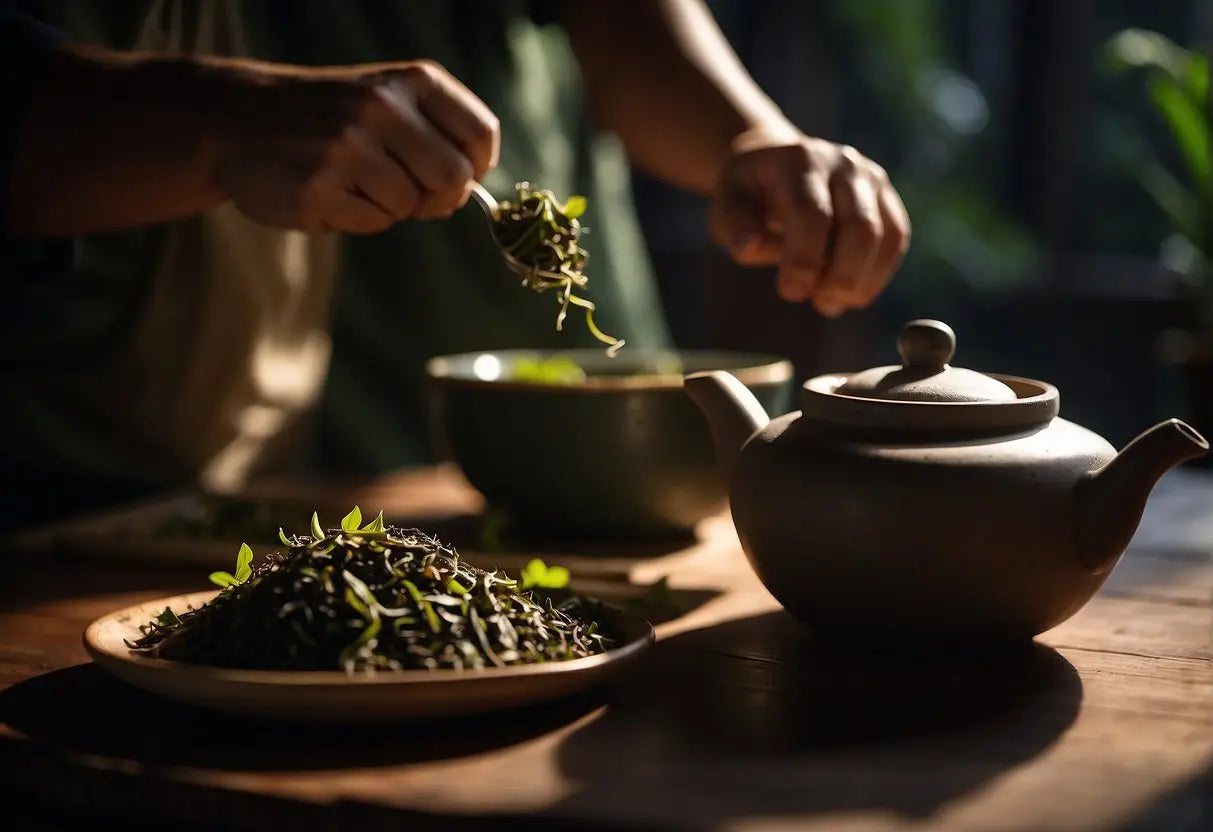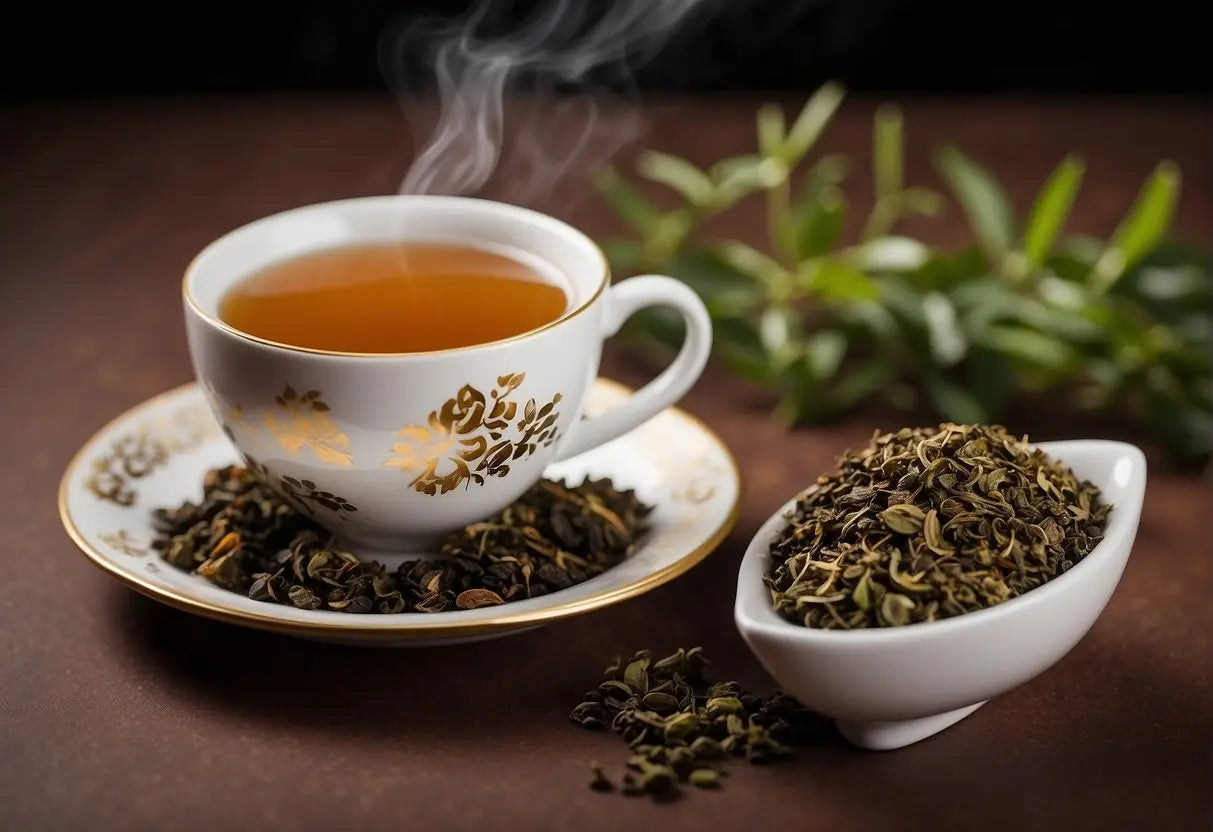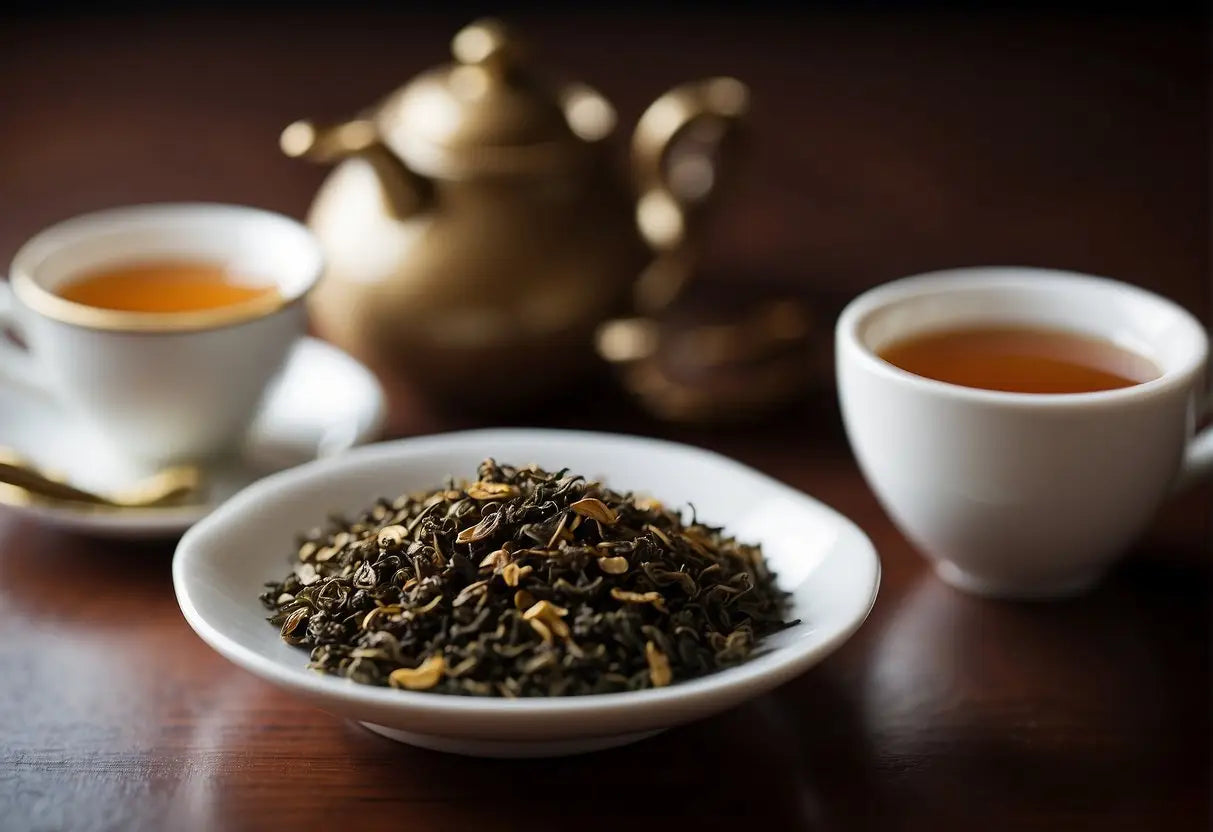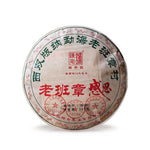Oolong vs Pu Erh: Understanding the Differences in Taste and Benefits
Shop our pu erh tea collections!
Oolong and Pu Erh teas are both esteemed for their unique flavors and traditional brewing methods. Oolong tea is partially oxidized, which places it between green tea (unoxidized) and black tea (fully oxidized) in terms of processing. Your experience with oolong can vary widely; it can range from light and floral to dark and full-bodied. Oolong tea is typically rolled or twisted into tight balls or thin strands and undergoes a meticulous process that involves wilting under the strong sun and oxidation before curling and twisting.
Pu Erh tea stands out due to its post-fermentation process. Originating from Yunnan province in China, Pu Erh is often aged, a process which can significantly enhance its depth of flavor. The tea comes in two types: raw (Sheng) and ripened (Shou). Sheng Pu Erh gradually ferments over time, while Shou Pu Erh undergoes a process to speed up fermentation, resulting in a smoother taste sooner.
Bestsellers
Here are key distinctions between the two:
- Origin: Oolong is primarily from China and Taiwan, while Pu Erh is from Yunnan, China.
- Oxidation: Oolong is partially oxidized, Pu Erh is post-fermented.
- Types: Oolong has varying levels of oxidation; Pu Erh has raw and ripened varieties.
Each type of tea has a recommended brewing temperature and time, which you can adjust to your taste:
-
Oolong:
- Temperature: 85-95°C (185-205°F)
- Time: 3-5 minutes
-
Pu Erh:
- Temperature: 95-100°C (203-212°F)
- Time: Variable, often longer for aged versions.
Check out our Sheng pu erh tea collection and Ripe pu erh tea collection.
Origins

In exploring the rich history of tea, you'll find that Oolong and Pu Erh teas stem from ancient traditions in China where their unique processing methods were developed and refined over centuries.
Oolong Tea Origins
Oolong tea, known for its diverse flavor spectrum, originates from China. Its history dates back to the Tang Dynasty in Fujian province, where the specific method of partial oxidation was cultivated. The process creates a balance between green and black teas, which gives Oolong its characteristic taste and aroma.
Pu Erh Tea Origins
Pu Erh tea hails from the Yunnan province of China. This tea is distinctive due to its post-fermentation process, which allows it to age and develop complex flavors. The history of Pu Erh can be traced to the traditional tea horse road, where it was compressed into cakes for ease of transport, enhancing its value and uniqueness as it traveled.
Processing Techniques

In this section, you'll learn the specific steps involved in processing both oolong and pu erh teas, which are crucial to their unique flavors and properties.
Oolong Tea Processing
Oolong tea is semi-oxidized, with oxidation levels varying between green and black teas. The process consists of:
- Withering: Fresh leaves are left to wither under the strong sun to reduce moisture.
- Shaking: The leaves are gently shaken in bamboo baskets to bruise the edges, starting oxidation.
- Oxidation: Leaves are spread out to oxidize to the desired level. The duration varies, affecting the flavor.
- Fixing: The leaves are briefly heated to halt oxidation at the right moment.
- Rolling: The tea is then rolled to shape the leaves and enhance flavor profiles.
- Drying: Finally, the tea is dried to lock in the flavors and prepare it for storage.
Pu Erh Tea Processing
Pu erh tea is a type of fermented tea with a unique production process that includes:
- Plucking: Leaves are harvested based on the desired pu erh style.
- Withering: Like oolong, these leaves are also withered to reduce moisture.
- Fixing: The leaves are heated to kill enzymes, stopping oxidation.
- Rolling: Leaves are rolled to shape them and break down their structure to assist fermentation.
- Drying: The tea is sun-dried, unlike other teas which may be oven-dried.
- Fermentation: Pu erh undergoes post-fermentation; 'Sheng' naturally over years, and 'Shou' rapidly through a controlled process.
- Aging: The tea can be aged for several years to enhance its depth and complexity.
Flavor Profiles

Lao Ban Zhang
When comparing oolong and pu erh teas, your palate will encounter a complex world of tastes. Each type of tea offers a distinct spectrum of flavors influenced by its processing and aging.
Oolong Tea Flavors
Oolong tea is known for its broad variation in flavor, which can range from sweet and fruity to woody and roasted. Key factors affecting taste include the origin of the tea, the altitude at which it's grown, and the level of oxidation it undergoes during processing. Here are some common flavor notes you might experience:
- Lightly oxidized oolongs: Floral, green, and fresh with a subtle creaminess.
- Heavily oxidized oolongs: Full-bodied with notes of stone fruit, honey, and a toasty finish.
Pu Erh Tea Flavors
Pu erh tea is another unique category, famous for its earthy, deep and often complex flavors that develop over time through fermentation and aging processes. Pu erh can be broken down into two main categories: raw (sheng) and ripe (shou), each with its own characteristic flavors:
- Raw Pu Erh (sheng): Can possess a more astringent taste initially that mellows out over time, gaining sweetness and floral tones.
- Ripe Pu Erh (shou): Often features a smoother, rich, and earthy profile with notes of wood, damp forest floor, and sometimes a hint of dark chocolate.
Varieties

Exploring diverse types of Oolong and Pu Erh teas reveals a spectrum of unique flavors and characteristics that cater to a wide range of preferences.
Oolong Tea Varieties
Oolong tea, with its origins in China, is partially oxidized and encompasses a variety of flavors ranging from sweet and fruity to thick and woody. Key varieties include:
- Tieguanyin (Iron Goddess of Mercy): Renowned for its floral aroma and complex taste.
- Da Hong Pao (Big Red Robe): Offers a rich, roasted flavor profile that's highly valued.
- Milk Oolong (Jin Xuan): Known for its creamy, smooth texture and natural milky taste.
Pu Erh Tea Varieties
Pu Erh tea, hailing from the Yunnan province of China, is a post-fermented tea with two main categories that influence its earthy tones:
-
Raw Pu Erh (Sheng):
- Young Raw Pu Erh: Exhibits fresh, green flavors and a mild astringency.
- Aged Raw Pu Erh: Develops complexity and smoothness over time.
-
Ripe Pu Erh (Shou):
- Early Aged Ripe Pu Erh (1-5 years): Features a more pronounced earthiness and less bitterness.
- Well-aged Ripe Pu Erh (10+ years): Matures to reveal deeper, richer flavors and aroma.
Brewing Methods

Brewing the perfect cup of Oolong or Pu Erh tea involves specific techniques that ensure the best flavor and aroma extraction.
Oolong Tea Brewing
To brew Oolong tea:
- Heat water to about 185°F-205°F (85°C-96°C), as Oolong teas generally prefer slightly cooler temperatures compared to black teas.
- Use approximately 1-2 teaspoons of Oolong tea leaves per 8 ounces of water.
- Place the tea leaves in your brewing vessel and pour the heated water over them.
- Steep for 3-5 minutes. Be aware that steeping for too long can result in bitterness.
- Oolong teas can often be re-infused several times, with each steeping revealing a new layer of flavors.
Pu Erh Tea Brewing
For Pu Erh tea:
- Boil water until it reaches a full rolling boil at 212°F (100°C).
- Measure about 1 teaspoon of Pu Erh tea per 8 ounces of water.
- Rinse your Pu Erh tea briefly with boiling water to "awaken" the leaves.
- Pour away the rinse water and then add the boiling water to the tea for brewing.
- Steep the tea for about 3-5 minutes. If you're brewing a compressed Pu Erh, you may need to extend the steeping time.
- Similar to Oolong, Pu Erh can often be steeped multiple times, with the flavor deepening with each infusion.
Health Benefits

When exploring the health benefits of oolong and pu-erh teas, it's important to note that both contain antioxidants, although their profiles can differ.
Oolong Tea:
- Weight Management: You may find that oolong tea supports metabolism, potentially aiding in weight loss efforts.
- Heart Health: Regular consumption can contribute to lower cholesterol levels, thereby supporting heart health.
- Blood Sugar Control: It might help in managing blood sugar levels, which is beneficial for those monitoring glucose.
Pu-erh Tea:
- Digestive Aid: Pu-erh is often consumed after meals as it's believed to aid digestion and help break down fats.
- Stress Reduction: Some studies suggest that the theanine in pu-erh can help reduce stress and promote relaxation.
- Detoxification: The fermentation process may introduce unique beneficial microbes that support the body's detoxifying efforts.
| Tea Type | Benefit | Potential Effect |
|---|---|---|
| Oolong | Metabolism Boost | Aids in weight management |
| Oolong | Heart Health Support | May lower cholesterol levels |
| Oolong | Glucose Regulation | Helps manage blood sugar levels |
| Pu-erh | Digestive Aid | Assists in the digestion of fats |
| Pu-erh | Stress Reduction | Contains theanine which aids relaxation |
| Pu-erh | Detoxification | Fermented tea supports detox processes |
It's important to understand that while these teas can be a valuable addition to your health regimen, they should not replace medical treatments or advice. The presence of caffeine in both teas might also affect individuals differently. Always consume these teas in moderation and consult with your healthcare provider about their role in your diet, especially if you have any health concerns.
Caffeine Content

When comparing the caffeine content in Oolong and Pu-erh teas, it's important to understand that both contain caffeine, though the amounts can vary. This variation is influenced by several factors such as the leaf age, processing methods, and brewing time.
-
Oolong Tea: Typically, a cup of oolong tea contains between 30 to 50 milligrams of caffeine. The range depends on whether the oolong is lighter (less oxidized) or darker (more oxidized). Lighter oolongs tend to have slightly less caffeine than their darker counterparts.
-
Pu-erh Tea: For Pu-erh tea, the caffeine content can vary widely, often between 30 to 70 milligrams per cup. The difference arises from Pu-erh's unique fermentation process and the length of aging.
Here's a brief comparison to give you a clearer picture:
| Tea Type | Average Caffeine Content (per 8 oz cup) |
|---|---|
| Oolong (light) | 30-40 mg |
| Oolong (dark) | 40-50 mg |
| Pu-erh | 30-70 mg |
To moderate your caffeine intake, you could adjust brewing times; shorter brewing yields less caffeine while longer brewing can extract more. Keep in mind that these are average values and your actual experience may vary based on specific tea types and brewing methods.
Storage and Aging

Proper storage is critical for maintaining the quality and enhancing the flavors of both Oolong and Pu Erh teas. Oolong teas require careful preservation to retain their delicate profiles, while Pu Erh teas can improve with age if stored correctly.
Oolong Tea Storage
When storing Oolong tea, you should keep it in a cool, dry place away from sunlight, odors, and moisture to prevent degradation of quality. It's best to store your Oolong tea in an airtight container—ceramic or tin are good choices. Here is a quick checklist for your Oolong tea storage:
- Temperature: Consistently cool, avoiding fluctuations
- Humidity: Low, with the use of desiccants if needed
- Container: Airtight, opaque, and odorless
- Location: Away from light, heat sources, and strong smells
Pu Erh Tea Aging
With Pu Erh tea, the aging process is integral to developing its unique earthy flavors. For aging Pu Erh, a controlled environment is crucial. You want to enable the tea to mature through microbial fermentation without risking mold or spoilage. The following are ideal conditions for aging Pu Erh tea:
- Temperature: 20-22°C (68-72°F) to promote fermentation
- Humidity: 60-70%, using a hygrometer to monitor
- Airflow: Some circulation, but not too drafty
- Storage unit: Wooden shelves or clay urns that allow tea to breathe
Remember, the quality and characteristics of Pu Erh can transform over years or even decades when stored under these conditions.
Frequently Asked Questions
In this section, you'll find detailed, evidence-based answers to common inquiries comparing Oolong and Pu-erh teas, focusing on health benefits, weight loss, flavor profiles, caffeine content, and processing methods.
What are the differences in health benefits between Oolong and Pu-erh teas?
Oolong tea is known for containing antioxidants called flavonoids and is linked to heart health and blood sugar control. Pu-erh tea, a type of fermented tea, is reputed for its potential to improve cholesterol levels and aid digestion.
How do Oolong and Pu-erh teas compare in terms of weight loss effects?
Research suggests that Oolong tea may boost metabolism and fat oxidation, possibly supporting weight loss. Pu-erh tea is also associated with weight loss, particularly due to the fermentation process, which is believed to help with fat reduction.
What are the distinct flavors and tastes of Oolong versus Pu-erh tea?
Oolong tea generally displays a range of tastes, from floral and fruity to creamy and woody, depending on oxidation levels. Pu-erh tea, however, offers an earthy, deep flavor profile that develops complexity as it ages, owing to the fermentation process.
Which has more caffeine, Oolong or Pu-erh tea, and how does it affect their consumption?
Oolong tea often contains more caffeine than Pu-erh tea but less than black or green teas. The caffeine content influences alertness and energy levels, which can determine preferable times of consumption according to personal tolerance and preference.
What are the main processing differences between Oolong and Pu-erh teas?
Oolong tea is partially oxidized, ranging from light to heavy oxidation, which affects its flavor and color. In contrast, Pu-erh undergoes a unique fermentation process after initial drying and rolling, contributing to its distinctive character and potential health benefits.
How do the potential health properties of Oolong tea compare to other types of teas?
While Oolong tea has a rich antioxidant profile helpful in reducing inflammation and promoting heart health, other teas like green tea also offer similar benefits with a higher concentration of catechins. The choice between teas often depends on personal health goals and taste preferences.
← Older post Newer post →











